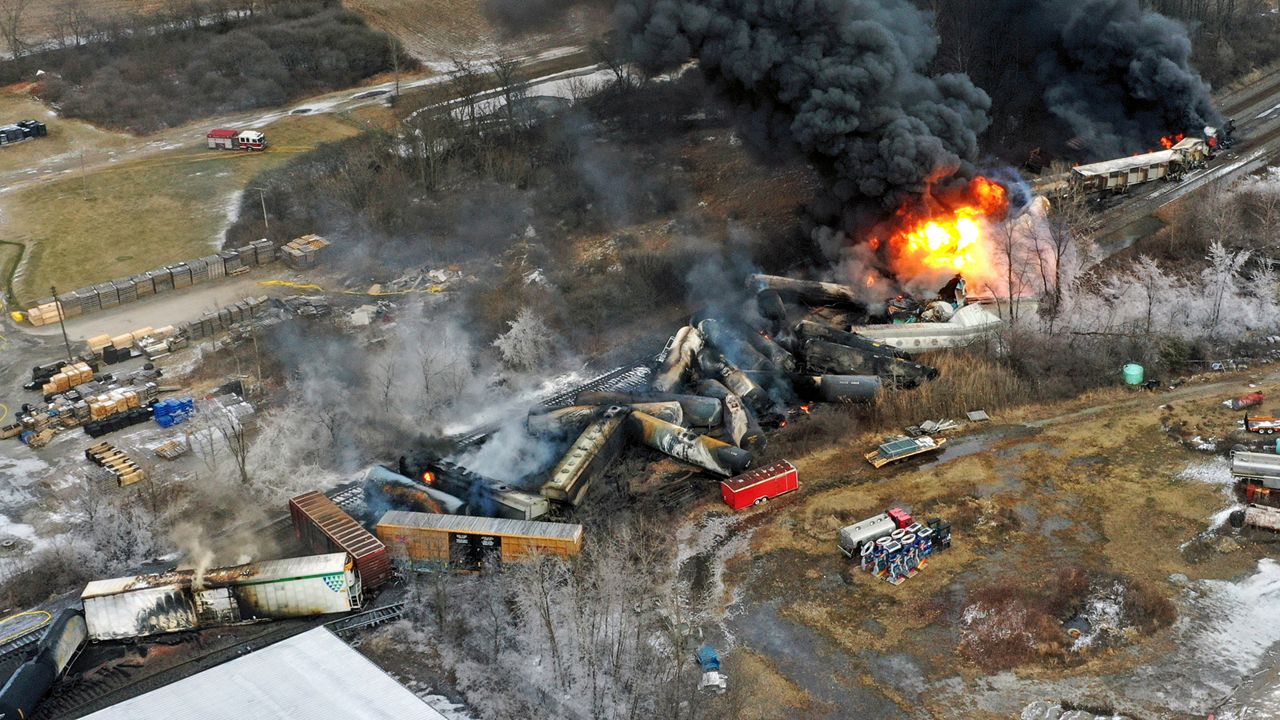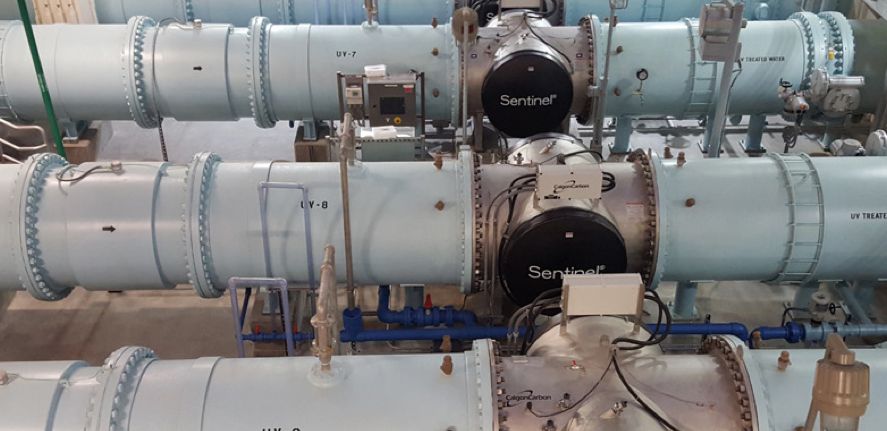CINCINNATI — Greater Cincinnati Water Works has reopened its Ohio River water intake, citing no detectable concentrations of chemicals related to the train derailment in East Palestine, Ohio.
What You Need To Know
- A low level of hazardous chemicals ended up in the Ohio River because of a train derailment in East Palestine earlier this month
- Greater Cincinnati Water Works closed its river intake Sunday ahead of the plume's expected arrival, but reopened it Monday after not detecting any chemicals
- A network of water utilities, environmental agencies and ORSANCO have conducted daily testing since the derailment on Feb. 3
- ORSANCO leaders believe most of the compounds became diluted by the Ohio River being at near-flood levels
The Ohio River Valley Water Sanitation Commission (ORSANCO) predicted any water-based chemicals from the derailment would arrive in Cincinnati over the weekend.
Water Works decided to close its Ohio River intake at 2 a.m. Sunday ahead of the plume’s expected arrival. Roughly 90% of the water supplied by Water Works comes from the river.
After extensive sampling and testing Sunday night and Monday morning, Water Works had found no trace of any chemicals, the organization said in a statement.
“The remnants of the polluted plume were expected to reach Louisville (Monday) morning, and I’m not even sure they’ll be detectable because the river is at such high levels and dilution factor was so strong,” said Richard Harrison, ORSANCO’s executive director and chief engineer.
No one suffered immediate injury because of the derailment, according to the Associated Press. But some of the train cars operated by Norfolk Southern leaked industrial chemicals. It’s believed that low levels of butyl acrylate seeped into the Ohio River through the Little Beaver Creek, about 300 miles north of Cincinnati.

Jeff Swertfeger, the superintendent of water quality and treatment for Water Works, said last week that samples taken downstream from the derailment contained trace amounts of the compound.
The risk of exposure for natural and man-made hazard substances is determined by the Agency for Toxic Substances and Disease Registry. It’s part of the U.S. Department of Health and Human Services.
Concern about water contamination of butyl acrylate starts when samples reach 560 parts per billion, Harrison said. He mentioned the highest reading during any testing of the Ohio River over the past three weeks reached 12 parts per billion in the Little Beaver Creek.
The testing also looked for three other industrial chemicals carried on the train: vinyl chloride, ethylene glycol monobutyl ether and ethylhexyl acrylate. So far, those haven’t been detected, Harrison said.
At least one river sample collected Sunday contained what Water Works described as “very low levels” of 2-Ethyl-1-hexanol. The chemical compound is commonly used in things like flavorings and fragrances.
Analysis of water drawn from its intake didn’t show a detectable concentration of that compound or any other chemicals from the derailment, per Water Works’ statement. But it closed the intake out of what it called “an abundance of caution.”
Water Works had been prepared to use water reserves while the intake remained closed.
On Monday, the public utility announced plans to “optimize its treatment processes” and monitor for these chemicals to ensure its plant is removing them.
Harrison noted the Ohio River is nearing flood stage near Cincinnati. That’s made the plume’s movement difficult to track, but it’s also helped remove most of the contaminants.
“For the last couple of days, we haven’t even seen it here at Cincinnati, let alone as it moves down the river,” he said. “We’re reaching a point where we can really only estimate right now because any remnants from the spill are very diluted and they probably won’t be detectable.”
Working to keep our rivers clean and drinking water safe
Since 1948, ORSANCO has worked with organizations from eight states to improve water quality in the Ohio River and its tributaries through regular monitoring for pollutants and toxins.
ORSANCO does things like set wastewater discharge standards, monitor waterways for chemicals, and perform biological assessments and special studies. The interstate commission also coordinates emergency response activities for spills or accidental discharges to the river, such as the derailment near the Pennsylvania state line.
“It’s our job to ensure the river is suitable for drinking water supply and industrial water supply after reasonable treatment and it’s also suitable to maintain aquatic life such as fish and bugs and for boating and other recreational uses,” Harrison said.
ORSANCO has 16 pieces of automated detection equipment along the Ohio River, primarily at water utilities, Harrison said. One of those is Water Works’ Richard Miller Treatment Plant on Kellogg Avenue. It’s next to ORSANCO’s headquarters.
The partners, along the river, run more than 1,000 preliminary screenings every day to test for 30 known volatile organic compounds (VCO), which are chemicals that both vaporize into air and dissolve in water.
Crews can also program the equipment for other VCOs after a chemical spill or another type of contamination, Harrison said. That’s what they did in this case.

They began testing near the derailment site at mile 40 of the Ohio River and are now well past mile 500, Harrison said.
To date, Greater Cincinnati Works alone has tested more than 160 water samples from its water intake looking for the chemicals from the derailment.
Melanie Houston, managing director of water policy for the Ohio Environmental Council, said she feels “very comfortable” telling those who live along the Ohio River should feel safe and comfortable that they’re drinking water is safe.
The Ohio Environmental Council is a nonprofit environmental advocacy organization.
Houston stressed ORSANCO has monitored the plume closely. She said she feels confident utilities, like Water Works, have the technology to treat the water appropriately.
The bigger concern is with the smaller bodies of water near the derailment site, she said.
Three days after the accident, authorities released and burned vinyl chloride inside five tanker cars, sending hydrogen chloride and the toxic gas phosgene into the air. Officials evacuated many of the roughly 5,000 people who live in the Columbiana County village.
“The Ohio River is a very big water body and so there is a dilution power with the Ohio River that you didn’t have in those smaller streams and bodies of water right when the vinyl chloride and the other chemicals hit in very high doses,” she said.
It’s not yet clear what the environmental impact will be in those areas.
While the technology is helpful, the relationships are the most important of the testing process, Harrison said.
The Ohio River basin is massive, spanning almost 200,000 square miles from northern Ohio to northern Georgia. It includes more than 275,000 miles of streams and waterways that flow into the Ohio River.
Train derailments don’t happen that often, Harrison said, but ORSANCO responds to a variety of situations throughout the basin. A notable incident took place in 2014 when a corroded storage tank at a Charleston, W. Va., business led to thousands of gallons of MCHM leaking into the Elk River.
“This is just what we do,” Harrison said. “All spills are different, but the processes we use and the tried-and-true training we have helps us keep the water safe for the millions of customers that rely on the Ohio River water supply.”
Sample collection is still pretty manual, Harrison said. Test operators work “around the clock” running samples and combing through data to share with partner organizations. ORSANCO uses the data to create flow patterns and make predictions about short- and long-term effects.
“If we know what’s happening in Wheeling or Huntington, for example, we’re going to have a better idea of what it’s going to be like when it reaches Cincinnati,” Harrison added.
Harrison admitted the past few weeks have been difficult for his team of 22 employees and the other responders. He described it as an all-hands-on-deck situation.
“It’s been exhausting,” he said.
Based on current conditions, Harrison is looking forward to ending the “emergency response,” but he reiterated that monitoring for chemicals from the derailment will continue for at least the next several months, he said.
“You never say never and that’s why it’s good to have that equipment in place,” Harrison said.



